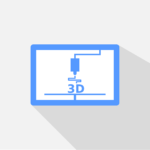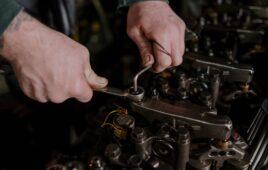Despite mainstream innovations in 3D printers, additive manufacturing has been primarily limited to prototypes for the fastener industry — until now. Advances in technology are transforming the speed and volume of manufacturing, specifically for plastic parts.

Additive manufacturing offers a streamlined and efficient method of printing many different parts, which can lead to simplified supply chains. These fasteners were printed in nylon and carbon fiber.
The latest in industrial 3D equipment uses resin material, offering automated functions capable of producing hundreds of thousands, if not millions, of parts per year. This is potentially game-changing for C-parts manufacturers in terms of production capacity and costs.
What’s more: rather than compete, this type of additive manufacturing can enhance and work side-by-side with conventional manufacturing, such as injection molding.
Understanding additives
Additive manufacturing or 3D printing is the process of building an object one layer at a time based on a digital file, and it has evolved significantly since its inception in the early ‘80s.
“Initially, additive manufacturing was considered extremely futuristic and almost Star Trek-like, where there was a magic box that could somehow make things,” shares Mason Fischer Paul, 3D Sales Engineer with Würth Additive Group, which supplies 3D printing and digital inventory solutions. “The technology was gate-kept for a while, and access was limited. But that’s changed over time.”
One reason for this change is because 3D printers have evolved, developing increased capacities and capabilities, and new methods of printing.
“There are now multiple methods of additive available using various materials and manufacturing methods,” says Paul. “The ideal method depends on the parts being produced and the production expectations.”
Fused deposition modeling (or FDM) is one such method, which quickly became one of the more popular and extensively used technique. Essentially, thermoplastic materials are extruded through a nozzle tip and then solidified.
“FDM is commonly used for plastics, but we’ve begun experimenting with DLP for plastic fastener manufacturing, and it has the potential to make a big impact in the fastener industry,” says Paul.

Mason Paul, 3D Sales Engineer with Würth Additive Group, which offers 3D printing and digital inventory solutions.
DLP or digital light processing is similar to SLA (stereolithography), an early additives invention that used a UV laser beam. But instead of a beam, DLP uses a UV light projector to rapidly produce photopolymer parts. It cures an entire layer of resin at a time, so the printing process is much faster than with SLA.
“The thing with fasteners is it’s necessary to keep up with extremely high volumes, and that’s where additive manufacturing has previously met limitations,” Paul explains. “If, for example, you’re printing three brackets, it’s typically going to print layer one of the first layer, one of the second, and one of the third layer. Then, it’s going to follow suit for the subsequent layers, essentially printing each, one at a time. This is not viable or efficient for high-volume production.”
However, advanced DLP equipment is leading to greater throughput, which is allowing for greater part production.
“With the latest in Rapid Shape 3D technology, if it takes 40 minutes to print one part, it’ll take the same 40 minutes to print 40 parts. It’s now possible to crank out parts extremely fast relative to other printing methods, whether it be laser-based printing or FDM printing,” he says. “And that’s a game-changer for fasteners.”
Rapid Shape is a tech company in the field of DLP technology that introduced the first resin 3D printer with fully automated functions to allow lights-out manufacturing processes, requiring little or no human intervention.
“By integrating a variety of smart systems, we’ve been able to increase production capacity, decrease human handling, and bring user safety to the forefront in resin production,” shares Andreas Schultheiss, CEO of Rapid Shape.
“With the growing adoption of UV-cured resin printing, we’re seeing tighter tolerances and faster production speeds that the fastener industry would benefit from,” Paul adds. “By using the Rapid Shape Inline, we’re capable of producing between one and three million parts a year, depending on size, material, specifications, and quality assurance.”
Standardizing production
Aside from volume requirements, manufacturing fasteners means certain specifications must be adhered to. This is something not yet standardized when 3D printing fasteners.
“Whenever I’ve toured fastener manufacturing plants, I’ve typically seen one machine continually running one specific part — such as a 1/4-20 x 1/2-inch bolt. So, this machine is set to produce that particular bolt to spec over and over, all day long,” says Paul. “Of course, this is important to limit any deviations. You don’t want a distributor to buy a million of these bolts only to find some two percent defective. Two percent of a million is a lot.”
This is particularly important in critical industries such as aerospace, automotive, or the military, where a fault bolt could have devastating impacts.
“If you’re manufacturing for the military, there are MIL specs. Aerospace has NASM specs, and each automotive company typically has its own specs called out where fastener threads must be within plus or minus a few thousandths of an inch, or what have you,” he says. “Limiting variance is essential.”

Jacob Ayers, Lead Technician with Würth Additive Group, removing printed parts from the Rapid Shape i50 3D printer.
Such specifications have not yet been standardized within additive manufacturing. In part, this is because the ability to print fasteners in larger volumes was previously impracticable, given the time and cost constraints of additive manufacturing. But it’s also because 3D printers were never designed to produce only one type of component.
“The organic evolution of 3D printing was always about variety,” says Paul. “Generally, people invested in a printer to produce hundreds or thousands of different parts. I probably have an archive of at least 1,000 different parts now, and if I had to tool up a CNC machine to manufacture every single one of them, it would take forever.”
However, necessity drives innovation, and 3D printers are evolving to meet differing demands. Automated equipment like that from Rapid Shape means standardized 3D printed parts are becoming a necessity.
“We’re committed to figuring out how to best build out standards for specific parts for these printers, so users can properly validate and archive CAD files, materials, part dimensions, and the equipment, ensuring the manufacturing is a benchmarked process and a repeatable one.”
Paul says the Würth Additive Group is collaborating with its partners — like Rapid Shape (which has the equipment expertise) and Henkel (a global chemical manufacturer with the resin and material expertise) — to create standards for certain plastic fasteners.
“It’s still early in the process, but we’re working through different PPAPs — which are production part approval processes — to validate that a part has been printed to specification. Ideally, we want to compare with injection molding as that’s one of the most common types of plastic manufacturing.”
Paul refrains from using the word “compete” with injection molding because he says such manufacturers are gaining interest in 3D printing to support their manufacturing lines.

Würth Senior Sales Engineer, Darren Brubaker, operating the Rapid Shape i50 — a high-performance industrial 3D printer that’s ideal for producing plastic fasteners.
“We’ve asked manufacturers to map out their part SKUs, and there’s typically a declining curve where the demand for certain types of fastener tapers off,” he says. SKUs are ‘stock keeping units,’ a unique number combination used to identify and track products. “We believe additive manufacturing can serve the tail end of such a bell curve, working alongside injection molding.”
This means determining which parts are in the lower percentiles of production and evaluating whether they’re potential candidates for additive manufacturing. As such, they could be manufactured with a 3D printer, saving the injection-molding equipment for the parts required in higher volumes.
“In this way, additive manufacturing is in no way a threat to more conventional forms of manufacturing and serves as a way to optimize a business and tackle new markets,” he says.
Paul has his team at Würth recently conducted a small in-house study on plastic fasteners to determine if 3D printing such smaller-volume parts would make a significant impact — and it certainly can.
“Smaller batch orders are going to cost a lot more, especially when considering the tooling and set-up that goes into typical manufacturing equipment. I mean the set-up alone can cost tens of thousands if not hundreds of thousands of dollars per run,” he says. “Whereas with a 3D printer, you simply need to plug it in once the material and CAD models are ready. There are no tooling charges or machine changeovers or anything like that.”
Before deciding to go with additive manufacturing, however, it’s important to properly evaluate the fastener type, project volume, and costs.
“I say this all the time: you can 3D print almost anything, but should you 3D print everything? Probably not. There’s an ideal time to do so that’s based on the part, material, cost, and overall manufacturing goals,” he says. “Nevertheless, we’re seeing a lot of change when it comes to breaking that barrier of 3D printing and how it’s implemented. It’s no longer just used for prototypes, but final production pieces. It’ll be exciting to see how the evolution of additive manufacturing progresses from here.”









Tell Us What You Think!